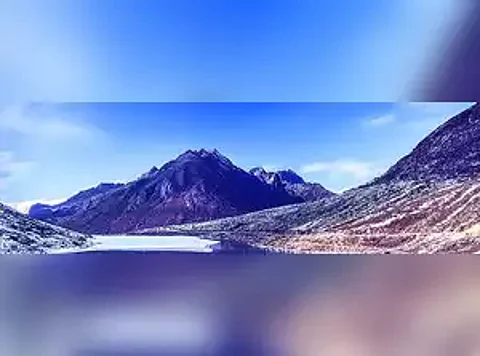
- Home
- Live Blog
- Breaking News
- Top Headlines
- Cities
- NE News
- Sentinel Media
- Sports
- Education
- Jobs

Researchers of Nagaland University and Cotton University documenting significant glacier retreats in Arunachal Pradesh over the past three decades have pressed the alarm bell on water availability for riparian communities in the state as well as Assam in the long term. The researchers, based on their study, have cautioned that shrinking glaciers may lead to short-term flooding and unstable river flows followed by long-term water shortages for communities that rely on glacial melt water. The study found that Arunachal Pradesh has lost 110 glaciers over 32 years, which has sounded the warning about the consequences of ignoring the rise in global temperature on account of climate change impact. Apart from communities in upper riparian areas in the state, communities in lower riparian areas in Assam are also dependent on glacier meltwater, with the glaciers in Arunachal Pradesh feeding major tributaries of the Brahmaputra. The study findings also remind us that the observation of this year as the International Year of Glaciers’ Preservation, officially launched by UNESCO and the World Meteorological Organisation, has high significance for glaciers in Arunachal Pradesh and the Northeast region. The study was recently published in the reputed, peer-reviewed Journal of Earth System Science, and the findings add to the growing evidence of climate change affecting the Eastern Himalayas, states an official release issued by Nagaland University. The efforts of the research team led by Dr. Latonglila Jamir of Nagaland University and Dr. Nabajit Hazarika of Cotton University, with research scholars Mr. Vimha Ritse and Ms. Amenuo Susan Kulnu to sound an alert about alarming development by documenting glacier retreat through their painstaking research, are praiseworthy. “The results show a marked reduction in glacier coverage. In 1988, 756 glaciers were covering around 585.23 square kilometres. By 2020, the number had dropped to 646, with the total area shrinking to 275.38 square kilometres. The researchers estimated an average glacier loss of 16.94 square kilometres per year. Smaller glaciers (less than 5 square kilometres) were found to be retreating faster,” states the release. Dr. Latonglila Jamir explains that the consequences of glacier retreat extend beyond the immediate region. “Communities that depend on glacial meltwater for agriculture and drinking water may face water shortages in the future. Initially, melting glaciers may lead to flooding and unstable river flows, but over time, the reduced glacial mass will result in lower water availability. The formation and expansion of glacial lakes also pose risks, as sudden floods caused by glacial lake outbursts (GLOFs) can be destructive.” He cautioned that it needs to be considered seriously by disaster management authorities in Assam and Arunachal Pradesh for potential disaster situations. A key recommendation by the research team for “continued monitoring and better climate adaptation strategies to manage water resources in the region” calls for more flow of research funds to support such scientific research on glaciers in Arunachal Pradesh that will help policymakers take urgent mitigation measures. The catastrophe caused by GLOF triggered by the bursting of South Lhonak Lake in Sikkim in 2023 is a grim reminder of prioritising GLOF risk management in the northeast region. The National Disaster Management Authority identified 27 high-risk lakes in high altitudes of five districts in Arunachal Pradesh, and findings by the latest research by the two universities call for making glacier preservation in the border state a top national priority so that there is no dearth of funding support for research and mitigation measures. In 2023, the central government informed the Parliamentary Standing Committee on Water Resources that Black Carbon (B.C.) aerosols accelerate glacier melting in the Himalayas. Black materials absorb more light and emit infrared radiation that increases the temperature. So, an increase in black carbon in the high Himalayas will contribute to the faster melting of Himalayan glaciers, the government told the parliamentary panel and added that the sources of B.C. reaching the Himalayan region are complex and remain uncertain due to a lack of field and reliable data. The government’s admission of the lack of reliable field data justifies a substantial increase in research funding for studies on glaciers in the region. Various study findings confirm alarming glacier retreats in Himalayan regions; the mitigation measures to check it and disaster preparedness to deal with GLOF and water availability issues cannot wait for more studies to be carried out first for preparing a plan of action. Any further delay in undertaking mitigation measures and conservation efforts on a scale to match the impending disaster will have a cascading and catastrophic impact. The central and state governments extending more financial assistance will facilitate collaborative studies by universities and research institutions to bring more credible data into the public domain to help governments formulate pragmatic strategies and time-bound action plan. The sustainability of agriculture and allied activities in the region requires urgent preparation of comprehensive healthcare for glaciers in Arunachal Pradesh.